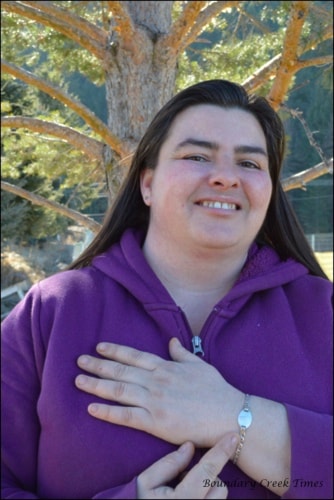Kettle Valley resident Jennifer Waygood wants to begin a conversation in the community about epilepsy.
March is Epilepsy Month and this is the first year that the Government of Canada has officially proclaimed March 26 as Purple Day.
Purple Day actually began in 2008 when Cassidy Megan, a child from Nova Scotia—at the time only nine years old—was motivated by her own struggles with epilepsy. Her goal was to get people talking about epilepsy in an effort to dispel myths and inform those with seizures that they are not alone.
Epilepsy is far more common that most people realize. It can occur at any age, is not contagious, and is rarely fatal. In Canada approximately 300,000 people have epilepsy and worldwide approximately 65 million people have epilepsy (more than multiple sclerosis, cerebral palsy, muscular dystrophy and Parkinson's combined) but many in the general public know little about it and much of what they do know is incorrect.
A seizure occurs when the normal electrical balance in the brain is lost. The brain's nerve cells misfire, either firing when they shouldn't or not firing when they should.
Seizures are the physical effects of these sudden, brief, uncontrolled bursts of abnormal electrical activity. The type of seizure depends on how many cells fire and which area of the brain is involved. The condition can result in either convulsive or non-convulsive seizures.
Treatment options include antiepileptic drugs, surgery, vagus nerve stimulation (a device that is surgically implanted and delivers a mild electrical current to the vagus nerve) or a ketogenic diet (high in fat, low in carbohydrates).
Jennifer says she’s had seizures all over the community; however, it is a disability that is usually invisible. Apart from the seizures, Jennifer is a completely normal 38-year-old wife and mother of three. In spite of her epilepsy she earned a four-year Bachelor of Social Work Degree at Okanagan University College in 2001.
Jennifer’s epilepsy was diagnosed two days before her 16th birthday but she believes her seizures actually started when she was eight or nine. “My seizures have changed as I got older. They were more visual seizures when I was a child. I didn’t know what to say or how to express the fact that I was seeing hallucinations and floating things in the air. If I asked my sister, ‘Did you see that? She’d say, see what?’ So I knew it was just me that was seeing these things. It was really difficult to really get out into the open.”
Eventually her seizures changed and became more physical and developed into grand mal seizures. That’s where they’ve stayed every since.
“Most of the research shows that as you age your seizures are supposed to ease and unfortunately that’s not what’s happening with mine—they are just getting worse.”
“I am on an awful lot of anti-epileptic medications,” she told the Times. “There isn’t a single one that I haven’t tried.
“They have given me the option of surgery but I am not really keen on it. I haven’t been able to speak to the others who have undergone this surgery so I am a little leery and they can’t promise that it will either reduce or remove any of the seizures.
“The only thing they can promise me is that it is going to reduce, if not take away complete vision in my right eye. The fact that they won’t let me talk to people who had this done doesn’t show me that these were bright outcomes.”
So despite experiencing an average of three seizures a week, she has backed off of the surgery option.
“They’ve given me the option of vagus nerve stimulation but it’s only something that they have proven for children. Basically they can’t seem to find something or a combination of things that work.”
For the public she suggests going online to learn how to properly deal with someone having a seizure—http://www.epilepsymatters.com has first-aid information for both convulsive and non-convulsive seizures.
There is an old myth that you should put something in a person's mouth during a seizure to keep them from swallowing their tongue. This is not true and can be dangerous.
“I’ve had people stick all kinds of things in my mouth and that is totally wrong.”
If somebody is witnessing someone having a seizure they need to be assisted to the ground and protected from hitting their head or injuring themselves. If the seizure lasts for more than five minutes, call 911.
Place them in the recovery position (on their side) and make sure they are not slapping anything. Once the seizure has ended, pat their back gently and continue talking to them, letting them know that there is somebody there.
For those who do have epilepsy she stresses the importance of always wearing a medic alert bracelet and carrying an up-to-date list of all medications.
“Epilepsy just needs to be brought to light and understood a little bit better. It’s a neurological problem that we have called epilepsy, and a symptom of the epilepsy is the seizures. Other than that we are really no different than anybody else.”
The B.C. Epilepsy Society has epilepsy awareness and educational materials available online at www.bcepilepsy.com.
“I definitely want this to get out because I know there are plenty of families with children who have some form of epilepsy and I want to help the community understand,” explained Jennifer.
